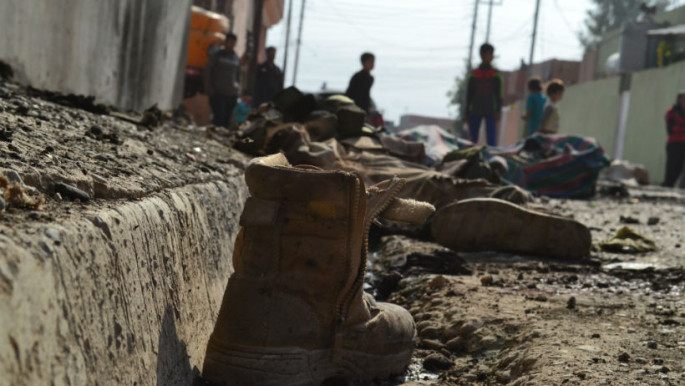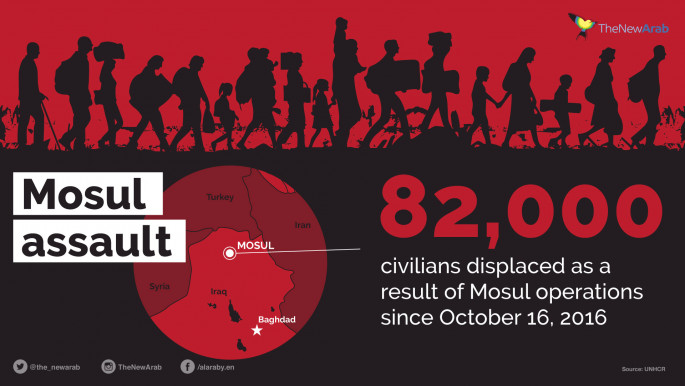Exclusive: Entering Mosul with Iraq's 9th Division
Exclusive: Entering Mosul with Iraq's 9th Division
In-depth: A first glimpse inside areas of Mosul liberated from the Islamic State group. Reporting by Gareth Browne.
4 min read
The Iraqi army has advanced into the first part of Mosul liberated from IS [TNA]
"We will spill our blood for Iraq," chanted the residents of Intasar, as Hummers from the Iraqi army's 9th division pushed into one of the first of Mosul's suburbs to be liberated from the Islamic State group.
Following the initial phase of the Mosul operation, which saw Iraqi and Peshmerga forces capture multiple towns and villages outside the city, initial incursions into urban areas presented a fresh challenge for Iraqi troops.
Following the initial phase of the Mosul operation, which saw Iraqi and Peshmerga forces capture multiple towns and villages outside the city, initial incursions into urban areas presented a fresh challenge for Iraqi troops.
With the Iraqi federal police acting as an auxiliary force, troops on this front have succeeded in pushing into several of the city's south-eastern suburbs.
But the urban warfare is fraught with risk, and Islamic State group fighters often use a network of tunnels and hide among the local population - many of whom have stayed, either by choice or by force, throughout the fighting - in order to launch attacks behind enemy lines.
One 9th division commander said that in these sorts of areas, some of his men are "too afraid to leave their Humvees".
A forward operating base just outside the city, in the village of Sharazad, is used by the men to regroup after their first incursions into the suburb. They were yet to establish a permanent base in the neighbourhood itself, deeming it too dangerous. We few journalists are herded into a convoy of all-terrain vehicles through the middle of the desert - the main roads, laden with IEDs, are too dangerous to use.
As the convoy enters the urban area, the empty streets begin to fill. The people here suffered for more than two years under the Islamic State group, they even stayed through most of the fighting. They largely stay indoors, afraid that IS fighters might find a way back in to the area.
But the urban warfare is fraught with risk, and Islamic State group fighters often use a network of tunnels and hide among the local population - many of whom have stayed, either by choice or by force, throughout the fighting - in order to launch attacks behind enemy lines.
One 9th division commander said that in these sorts of areas, some of his men are "too afraid to leave their Humvees".
A forward operating base just outside the city, in the village of Sharazad, is used by the men to regroup after their first incursions into the suburb. They were yet to establish a permanent base in the neighbourhood itself, deeming it too dangerous. We few journalists are herded into a convoy of all-terrain vehicles through the middle of the desert - the main roads, laden with IEDs, are too dangerous to use.
 |
|
| In pictures: Explore more of this story with Gareth's exclusive photoblog: A first glimpse inside Mosul |
As the convoy enters the urban area, the empty streets begin to fill. The people here suffered for more than two years under the Islamic State group, they even stayed through most of the fighting. They largely stay indoors, afraid that IS fighters might find a way back in to the area.
But the roaring engines of the US-built Iraqi army Hummers injects a fearlessness - a confidence that might have proved dangerous under the administration of IS. Children run to the vehicles, and soldiers, drawn overwhelmingly from Iraq's Shia south, hand out water and bread. A crowd quickly gathers, and a chant oozing national pride is belted out. One man erupts in tears, and a microphone is pushed in front of his mouth by local Kurdish media "thanks God for the army," he yells.
There is no doubt that this is a genuine display of emotion and gratitude, but others sit on the pavement, apparently unimpressed by the army's incursion into their streets. It would appear there is a silent majority here, people who were not as disillusioned with the jihadists' experiment as much commentary would suggest - and whether they will become something more than silent onlookers as the army ventures further into the largely Sunni city remains to be seen.
This is a deeply conservative Sunni neighbourhood, even in the wake of the IS defeat, the few women seen in the streets here continue to wear niqabs, and men to continue to sport their lengthy beards, with no hair above the top lip - a Salafi trademark.
The convoy swings a sharp left before moving deep into the suburb, and ahead on the street lie the charred corpses of four Islamic State group fighters. Their eyes fused shut, they fester on the street peacefully, but their passing was clearly anything but peaceful. Evidence of a firefight lies all around, the wall is charred black, and a small mortar crater dents the centre of the pavement.
Three of the bodies have limbs blown off, and some 10 metres away, a detached foot sits on the asphalt, its owner unknown. There have been no efforts to dispose of the bodies. After three days, they have begun to fill the air with an emetic odour; on th enow-quiet streets, they are a surreal reminder of the suburb's traumatic recent past.
 |
| [Click to enlarge] |
In the distance, fighting rages on, mortar strikes are clearly audible, and machine guns rattle intermittently. Just over a kilometre away is the district of Gogjali, where a CNN news team spent more than 24 hours trapped in a Humvee after being caught up in an Islamic State group ambush.
For all the column inches and Twitter analysis declaring that the Islamic State group is on the back foot, it is evident here in Intasar, perhaps better than anywhere else, that they still instill grave fear both in the local population and the Iraqi army.
It's also hard to believe that they don't hold popular support with at least some of the residents.
Almost en cue, as a man ventures out from behind his front gate to tell me how happy he is about the Islamic State, a 9th division commander yells at me to return to my vehicle, and in minutes we are whisked away, back to the relative safety of Sharazad.
It's also hard to believe that they don't hold popular support with at least some of the residents.
Almost en cue, as a man ventures out from behind his front gate to tell me how happy he is about the Islamic State, a 9th division commander yells at me to return to my vehicle, and in minutes we are whisked away, back to the relative safety of Sharazad.
Gareth Browne is reporting from the front lines in the battle for Mosul. Follow him on Twitter: @BrowneGareth
For more on this story, check out Gareth's photoblog: A first glimpse inside Mosul



